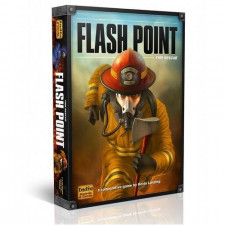Flash Point: Fire Rescue Review
on May 12, 2015
Kevin Lanzing’s 2011 design Flash Point: Fire Rescue offers a few elements that are almost always in the recipe for a great co-op game. One is that the game needs to depict a team activity – like, say, fighting fires and rescuing folks from burning buildings. It has subject matter backed up with mechanics that make thematic sense. So there are no artificially gamey rules that prohibit players from communicating information with each other. And it is also scalable, accommodating a wide range of player counts and skill levels without ever feeling artificially challenging or unfair.
Skill level is handled in the old-fashioned way: with beginner and advanced rules. Nothing revolutionary there, and at first glance, the mechanic for player count seems as simple: each player conducts their firefighting actions and then rolls dice to spread the fire to a new space on the board. One player has to deal with one spread per turn. Six players deal with six. That’s it, but it works. Since it can be a challenge for a player to get to and extinguish a fire each turn, the mechanic creates a gradually spreading fire each game, a ticking clock regardless of player count. Keep the flames under control and get the victims out before the structure collapses or the fire consumes them. The stakes are high, and an out-of-control fire forces players to work together.
To rescue the required minimum of seven victims before spreading flames weaken and eventually collapse the structure, players need to split duty between carrying stricken men, women and pets to safety and keeping the flames at bay. This need opens the door for the alpha player or quarterback, the one player who tells everyone what to do, essentially playing the game while the others take orders. But Flash Point’s gameplay quickly slams the door on this kind of group dynamic due to its open nature. Victims only appear on the board three at a time and fire dice are the essence of randomness, preventing the alpha from seeing all things on turn one and thus allowing everyone to be part of the plan. No clear path to victory means no discernible patterns emerge.
Gameplay does introduce some dissonant mysteries which can cloud the fun. Victims appear randomly, and a helpless man can pop up in the same room you just carried a woman out of, a room empty until your teammate took their turn. Explosions can knock fighters down, magically transporting them out of the building to the nearest ambulance where an instant recovery occurs. But hey- board games.
Advanced rules take the game to the next level, offering either a progression for families wanting more or a richer game for those seeking a deeper dive. Players can choose specific roles with altered abilities from the standard fire fighter, enabling customization of the team and variability of gameplay. Medics heal injuries, the captain empowers other teammates, and a cannon operator can use the truck to douse entire sections of a burning building.
Customization doesn’t end there. Hot spots cause dangerous flare-ups, spreading the fire quicker. Hazardous chemicals (haphazardly stored in a kid’s bedroom or in the living room) might spark off and blow up a wall. There are a number of variables that can be mixed and matched, allowing players to create their own level of challenge. Flash Point gives the level of difficulty players want in a tense fashion, weaving straightforward rules into a formidable test of teamwork and skill.
The game community credits Settlers of Catan with opening the public’s eyes to the range of possibilities between Monopoly and Dungeons and Dragons, but Catan can’t truly be called a gateway game. Flash Point: Fire Rescue can. It draws the casual gamer in with colorful miniatures, simple rules and a clear progression of risk and reward, illustrating a world beyond roll-and-move and allowing role-playing that doesn’t involve elves or magic wands. It has a real-world setting that anyone can grasp and easily understand, which makes the goals and actions feel more concrete. It’s not a perfect firefighting simulation, which makes it more accessible. It is a perfect way to introduce friends and family to a larger gaming world.

 Customer Support
Customer Support  Subscribe
Subscribe 




 Account
Account  Wishlist
Wishlist 

